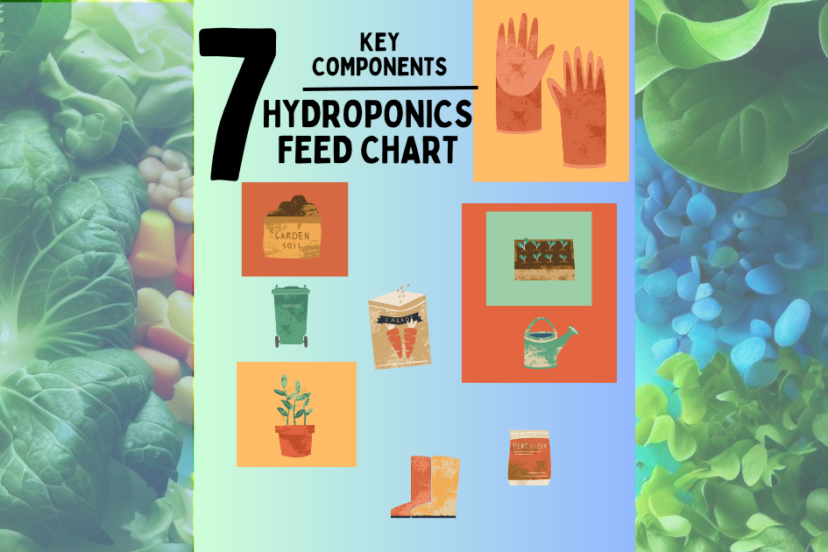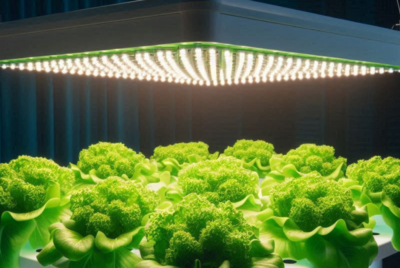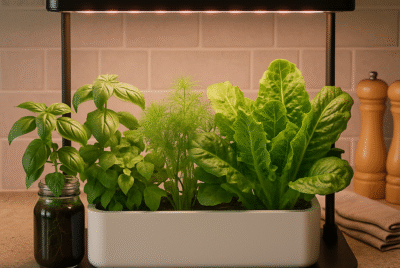General Hydroponics Feed Chart
In the world of hydroponics, nutrient management plays a vital role in ensuring healthy plant growth and bountiful harvests. I understand the challenges of providing the right balance of nutrients to hydroponic plants. One valuable tool that can aid in this process is a General Hydroponics
Feed Chart. In this article, I will delve into the significance of utilizing a feed chart and provide helpful suggestions for maximizing its benefits.
The Benefits of Using a General Hydroponics Feed Chart
A well-designed feed chart serves as a roadmap for nutrient application in hydroponic systems. It offers a range of advantages, including:
1. Optimal Nutrient Balance: A feed chart provides a precise blend of nutrients required for each growth stage, ensuring plants receive the right elements in the right proportions.
2. Simplicity and Convenience: By following a feed chart, growers can streamline their nutrient management process, eliminating guesswork and reducing the risk of under- or over-fertilization.
3. Promotes Plant Health: The proper nutrient ratios provided by a feed chart support robust plant growth, vibrant foliage, and enhanced nutrient absorption, leading to healthier and more productive plants.
4. Customizable for Different Varieties: A feed chart can be tailored to suit different plant varieties, accounting for their specific nutrient requirements and growth characteristics.
5. Time and Resource Efficiency: Utilizing a feed chart saves time and resources by minimizing the need for constant adjustments and experimentation with nutrient dosages.
Exploring the Components of a General Hydroponics Feed Chart
A comprehensive feed chart consists of essential components that guide growers in achieving optimal nutrient balance. These components include:
1. Base Nutrients
The base nutrients form the foundation of the feed chart. They typically include macronutrients such as nitrogen (N), phosphorus (P), and potassium (K), along with secondary macronutrients like calcium (Ca), magnesium (Mg), and sulfur (S). Each nutrient serves specific roles in plant development and must be provided in appropriate quantities.
2. Supplements and Additives
Supplements and additives enhance the nutrient solution by providing additional elements or enhancing nutrient uptake. Examples include beneficial microbes, root stimulants, bloom boosters, and pH stabilizers. These additives address specific plant needs and can be incorporated into the feed chart based on the grower’s goals and plant requirements.
3. pH and EC Levels
The feed chart should include guidelines for maintaining the pH and electrical conductivity (EC) levels of the nutrient solution. Proper pH ensures nutrient availability and absorption, while EC indicates the concentration of dissolved nutrients in the solution. Monitoring and adjusting these levels is crucial for maintaining plant health.
4. Growth Stages
The feed chart should outline nutrient requirements for different growth stages, such as seedling, vegetative, and flowering stages. Each stage has unique nutritional demands, and the feed chart should provide specific nutrient ratios and dosage recommendations for optimal growth during each phase.
Customizing the Feed Chart for Different Plant Varieties
Different plant varieties have varying nutritional needs. Therefore, it is essential to customize the feed chart based on the specific requirements of the plants you are growing. Consider factors such as the plant’s nutrient uptake preferences, growth rate, and flowering characteristics. By tailoring the feed chart to the specific needs of your plant varieties, you can maximize their growth potential and achieve exceptional results.
Adjusting the Feed Chart for Growth Stages
As plants progress through different growth stages, their nutritional requirements change. The feed chart should provide guidance on adjusting nutrient ratios and concentrations accordingly. For example, seedlings may require higher nitrogen levels for vigorous vegetative growth, while flowering plants may benefit from increased phosphorus and potassium to support blooming and fruiting. Regularly monitor your plants’ growth stage and adjust nutrient application as indicated in the feed chart to ensure optimal nutrient balance throughout their development.
The Role of pH and EC Levels in Hydroponic Nutrient Solutions
Maintaining proper pH and EC levels in the nutrient solution is critical for nutrient availability and plant health. The feed chart should emphasize the significance of monitoring and adjusting these levels regularly. pH levels affect nutrient solubility and uptake, with most hydroponic plants thriving in a slightly acidic range between 5.5 and 6.5. The EC level indicates the concentration of nutrients in the solution, and the feed chart should provide target ranges suitable for different growth stages. By carefully managing pH and EC levels, growers can optimize nutrient absorption and prevent nutrient imbalances or deficiencies.
Monitoring and Adjusting Nutrient Levels for Optimal Growth
Regular monitoring of nutrient levels is essential to ensure plants receive adequate nutrition. The feed chart should encourage growers to measure the pH and EC of the nutrient solution regularly, preferably before each nutrient application. By using pH meters and electrical conductivity meters, growers can accurately assess the nutrient solution’s acidity, nutrient concentration, and adjust them as needed. This proactive approach allows for timely intervention and prevents nutrient-related issues that could hinder plant growth.
Troubleshooting Common Issues with Nutrient Management
Even with a well-designed feed chart, challenges can arise in nutrient management. The feed chart should include troubleshooting tips for common issues, such as nutrient deficiencies, nutrient toxicities, pH imbalances, and EC fluctuations. By addressing these problems promptly and implementing corrective measures, growers can ensure their plants remain healthy and thrive in their hydroponic systems.
Tips for Implementing and Following a General Hydroponics Feed Chart
Implementing a general hydroponics feed chart effectively requires attention to detail and adherence to best practices. Here are some valuable tips to consider:
1. Follow the Recommended Dosages: Stick to the recommended nutrient dosages provided in the feed chart. Avoid the temptation to over-fertilize, as it can lead to nutrient imbalances or toxicity.
2. Monitor Plant Response: Pay close attention to your plants’ response to the nutrient solution. Observe leaf color, growth rate, and overall plant health. Adjust nutrient levels if you notice any signs of deficiency or excess.
3. Maintain Cleanliness and Sterility: Ensure your hydroponic system, growing containers, and tools are clean and free from contaminants. Maintain a sterile environment to prevent the growth of harmful pathogens or algae.
4. Keep Detailed Records: Maintain a log of your nutrient applications, pH and EC measurements, and any adjustments made. This record-keeping helps track plant progress and facilitates troubleshooting if issues arise.
5. Seek Expert Advice: Consult with experienced hydroponic growers or horticulture professionals
for guidance and support. They can provide valuable insights, answer specific questions, and offer tailored advice based on their expertise and experience.
General Hydroponics Feed Chart:
Lettuce, Tomatoes, Cucumbers, Mushrooms, and Strawberries
Proper nutrition is crucial for the healthy development and productivity of hydroponic plants. By providing the right balance of macro and micronutrients, we can optimize their growth and ensure abundant harvests. Let’s explore the nutrient requirements for each plant and the stages of their growth.
1. Lettuce
Optimal Nutrient Requirements
Lettuce, a popular leafy green, thrives in hydroponic systems. To maximize its growth potential, it requires specific nutrients. The optimal nutrient requirements for lettuce include nitrogen, potassium, calcium, and micronutrients such as iron and magnesium.
Feeding Recommendations
To meet the nutrient requirements of lettuce, follow this feeding recommendation:
1. In the vegetative stage, use a nutrient solution with a balanced ratio of N-P-K (Nitrogen-Phosphorus-Potassium) in the range of 3:1:2.
2. During the flowering stage, adjust the nutrient solution to have a higher potassium concentration to support fruiting.
Base Nutrients
Lettuce requires a balanced blend of nitrogen (N), phosphorus (P), and potassium (K) throughout its growth stages. These macronutrients play a vital role in leaf development, root growth, and overall plant health.
Supplements and Additives
To enhance lettuce growth, consider incorporating calcium nitrate, epsom salt (magnesium sulfate), and iron chelate into your nutrient solution. These additives provide essential micronutrients and promote vibrant, healthy foliage.
pH and EC Levels
Maintaining the correct pH and electrical conductivity (EC) levels is crucial for nutrient uptake. Lettuce thrives in a pH range of 5.5-6.5, while the recommended EC range is 1.2-1.8 mS/cm.
Growth Stages
Lettuce goes through three primary growth stages: seedling, vegetative, and flowering. Adjust the nutrient solution accordingly to meet the plant’s changing needs and promote optimal growth at each stage.
2. Tomatoes
Optimal Nutrient Requirements
Tomatoes are a staple in many hydroponic gardens, and they have distinct nutrient needs. The optimal nutrient requirements for tomatoes include a balanced combination of macronutrients like nitrogen, phosphorus, potassium, and secondary nutrients like calcium and magnesium.
Feeding Recommendations
To provide tomatoes with the right nutrition, consider the following feeding recommendations:
1. In the early growth stage, use a nutrient solution with a balanced N-P-K ratio, such as 3:1:2, to promote healthy foliage development.
2. During the fruiting stage, increase the potassium concentration in the nutrient solution to enhance fruit quality and yield.
Feeding Recommendations
To provide tomatoes with the right nutrition, consider the following feeding recommendations:
1. In the early growth stage, use a nutrient solution with a balanced N-P-K ratio, such as 3:1:2, to promote healthy foliage development.
2. During the fruiting stage, increase the potassium concentration in the nutrient solution to enhance fruit quality and yield.
Base Nutrients
Tomatoes require a balanced supply of nitrogen, phosphorus, and potassium to support their vigorous growth and abundant fruit production. These nutrients contribute to strong stems, healthy foliage, and robust root systems.
Supplements and Additives
To enhance tomato growth, incorporate calcium nitrate, potassium sulfate, and phosphoric acid into your nutrient solution. These additives provide crucial micronutrients and stimulate flowering and fruit development.
pH and EC Levels
Tomatoes prefer a slightly acidic pH range of 5.8-6.8, with an EC range of 1.8-2.5 mS/cm. Maintaining these levels ensures optimal nutrient absorption and prevents nutrient deficiencies or imbalances.
Growth Stages
Tomatoes go through three main growth stages: seedling, vegetative, and flowering. Adjust the nutrient solution composition and concentration as the plant progresses through each stage to maximize growth and yield.
3. Cucumbers
Optimal Nutrient Requirements
Cucumbers thrive in hydroponic systems, and meeting their nutrient requirements is vital for a successful harvest. Cucumbers have high potassium demands, along with the need for nitrogen, phosphorus, calcium, and magnesium.
Feeding Recommendations
To ensure optimal growth and productivity of cucumbers, follow these feeding recommendations:
1. Provide a nutrient solution with a balanced N-P-K ratio, such as 3:1:2, during the vegetative stage to support vigorous vine growth.
2. Increase the potassium levels in the nutrient solution during the flowering and fruiting stages to encourage abundant and high-quality cucumber production.
Base Nutrients
Cucumbers require a balanced supply of nitrogen, phosphorus, and potassium for robust growth and abundant fruiting. These nutrients contribute to strong vines, lush foliage, and healthy cucumber production.
Supplements and Additives
To enhance cucumber growth, include calcium nitrate, potassium sulfate, and magnesium sulfate in your nutrient solution. These additives provide essential micronutrients and promote optimal flowering and fruit set.
pH and EC Levels
Cucumbers thrive in a pH range of 5.8-6.5, with an EC range of 2.0-2.5 mS/cm. Maintaining these levels ensures proper nutrient absorption and supports healthy cucumber development.
Growth Stages
Cucumbers have three main growth stages: seedling, vegetative, and fruiting. Adjusting the nutrient solution composition and concentration throughout each stage is essential to meet the plant’s changing requirements and maximize productivity.
4. Mushrooms
Optimal Nutrient Requirements
Mushrooms have unique nutritional needs due to their fungal nature. While they don’t require traditional macronutrients, they rely heavily on organic matter and specific micronutrients like phosphorus, potassium, and trace minerals.
Feeding Recommendations
To cultivate healthy mushrooms, consider the following feeding recommendations:
1. Create a nutrient-rich substrate using materials like compost, straw, and hardwood sawdust.
2. Maintain proper moisture levels and provide a suitable environment for mycelium colonization and fruiting body formation.
Base Nutrients
Mushrooms have unique nutrient requirements compared to other plants. They primarily require a substrate rich in organic matter, such as compost or specialized mushroom growing medium. The substrate provides the necessary nutrients for mushroom growth.
Supplements and Additives
To promote mushroom development, maintaining proper humidity and temperature levels is crucial. Additionally, adding supplements like gypsum, calcium carbonate, and yeast extract can enhance the nutrient profile of the substrate and support healthy mushroom growth.
pH and EC Levels
Mushrooms thrive in a slightly acidic to neutral pH range of 6.0-7.0. EC levels are not as relevant in mushroom cultivation since they don’t rely on nutrient solutions like other hydroponic plants.
Growth Stages
Mushroom cultivation involves different stages, including substrate preparation, inoculation, colonization, and fruiting. Each stage requires specific environmental conditions and careful management to ensure successful mushroom production.
Nutrient Requirements
Spawn Run Stage:
– Substrate composition varies based on mushroom type. Consult specific guidelines for optimal nutrient requirements.
Fruiting Stage:
– Maintain humidity levels around 90%
– Provide fresh air exchange to facilitate growth
5. Strawberries
Optimal Nutrient Requirements
Strawberries are delicate and flavorful fruits that can thrive in hydroponic setups. They require balanced nutrition, with an emphasis on nitrogen, phosphorus, potassium, and trace elements like iron and manganese.
Feeding Recommendations
To promote vigorous growth and abundant strawberry production, follow these feeding recommendations:
1. Provide a nutrient solution with a balanced N-P-K ratio, such as 2:1:3, during the vegetative stage for robust foliage development.
2. Adjust the nutrient solution during the flowering and fruiting stages to have a higher potassium concentration for enhanced flowering and larger, sweeter berries.
Base Nutrients
Strawberries have specific nutrient requirements for vigorous growth and abundant fruiting. They need a balanced supply of nitrogen, phosphorus, and potassium, along with adequate levels of calcium and magnesium.
Supplements and Additives
Incorporating supplements like calcium nitrate, potassium sulfate, and magnesium sulfate can enhance strawberry growth and improve fruit quality. These additives provide essential micronutrients and support flowering and fruit development.
pH and EC Levels
Strawberries thrive in a slightly acidic pH range of 5.5-6.5. The recommended EC range is 1.2-2.0 mS/cm. Maintaining proper pH and EC levels ensures optimal nutrient absorption and prevents nutrient deficiencies or toxicities.
Growth Stages
Strawberries go through several growth stages, including establishment, vegetative growth, flowering, and fruiting. Adjusting the nutrient solution composition and concentration based on the plant’s growth stage is essential for healthy plant development and maximum yield.
Conclusion
A general hydroponics feed chart is an invaluable tool for hydroponic growers seeking to optimize nutrient management and maximize plant growth. By following a well-designed feed chart, growers can ensure their plants receive the essential nutrients in the right proportions at each growth stage. The customization of the feed chart based on plant varieties and the regular monitoring of pH and EC levels contribute to optimal nutrient balance and plant health. By troubleshooting common issues and adhering to best practices, growers can achieve exceptional results in their hydroponic systems.
Remember, each plant is unique, and fine-tuning the nutrient management process may require experimentation and adjustments. With patience, observation, and a commitment to providing the best possible nutrition, you can unlock the full potential of your hydroponic plants and enjoy the rewards of a thriving indoor garden.
FAQs
1. What if my plants show signs of nutrient deficiency even when following the feed chart?
If your plants display signs of nutrient deficiency, despite following the feed chart, it could indicate other factors at play, such as pH imbalances or root-related issues. Conduct a thorough assessment of your hydroponic system, including pH levels, root health, and environmental conditions, to identify and address the underlying cause of the issue.
2. Can I use a general hydroponics feed chart for all plant varieties?
While a general hydroponics feed chart provides a solid foundation, some plant varieties may have specific nutritional requirements that go beyond the general guidelines. It’s essential to research and understand the unique needs of each plant variety you intend to grow and make necessary adjustments to the feed chart accordingly.
3. How often should I adjust the nutrient concentrations in the feed chart?
The nutrient concentrations in the feed chart may need adjustment based on factors such as plant growth stage, environmental conditions, and specific plant requirements. Regular monitoring of pH and EC levels, as well as careful observation of plant response, will help determine when adjustments are necessary. Aim to review and adjust nutrient concentrations as needed throughout the growth cycle.
4. Can I create my own customized feed chart?
Yes, experienced hydroponic growers often customize feed charts based on their specific requirements and plant varieties. It requires a deep understanding of plant nutrition, nutrient ratios, and growth stages. Start with a reputable general feed chart as a baseline and modify it based on your observations and plant responses.
5. Is it necessary to use the same brand of nutrients as mentioned in the feed chart?
While the nutrient brand mentioned in the feed chart may provide consistent results. You can use equivalent nutrient solutions from reputable brands. Ensure the nutrient solutions you choose provide the required macro and micronutrients. It’s advisable to cross-reference nutrient formulations and consult with experienced growers if needed.
Remember, the key to successful nutrient management lies in understanding the unique needs of your plants, closely monitoring their growth, and making adjustments as necessary. Happy hydroponic gardening!
*We may earn a commission from purchases made through our links, at no cost to you. This does not affect our product recommendations. Please see our disclosure to learn more.




